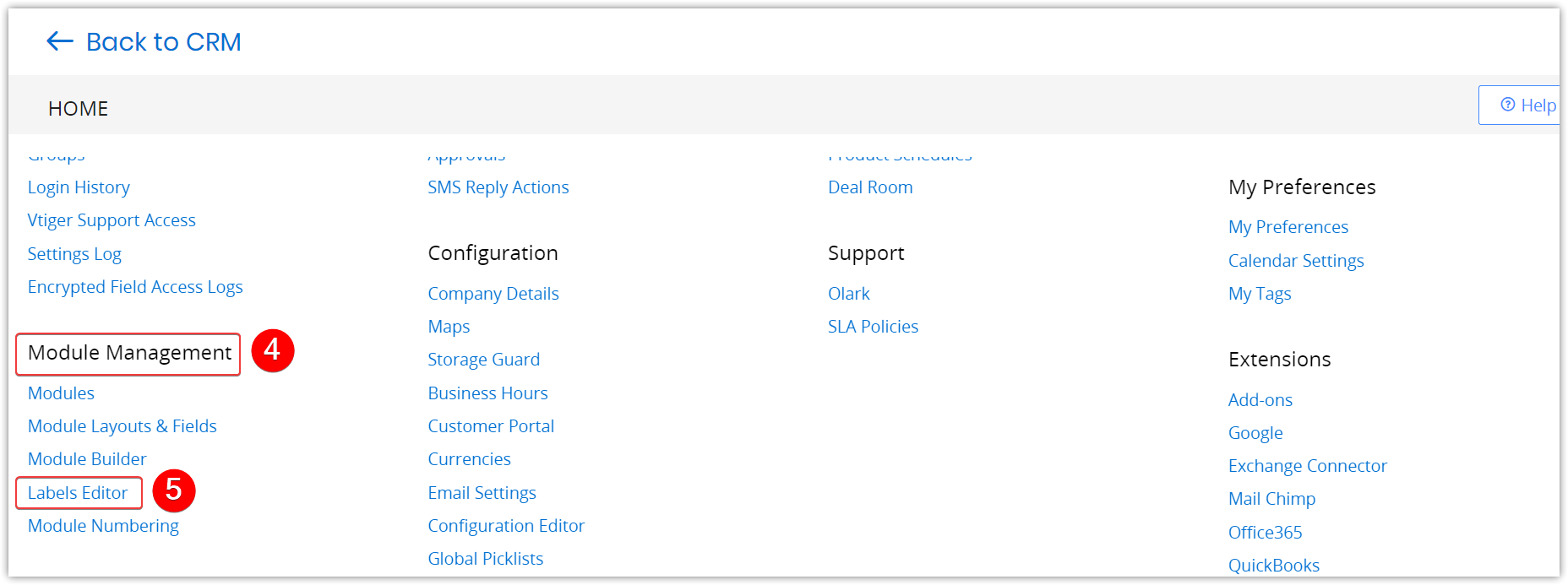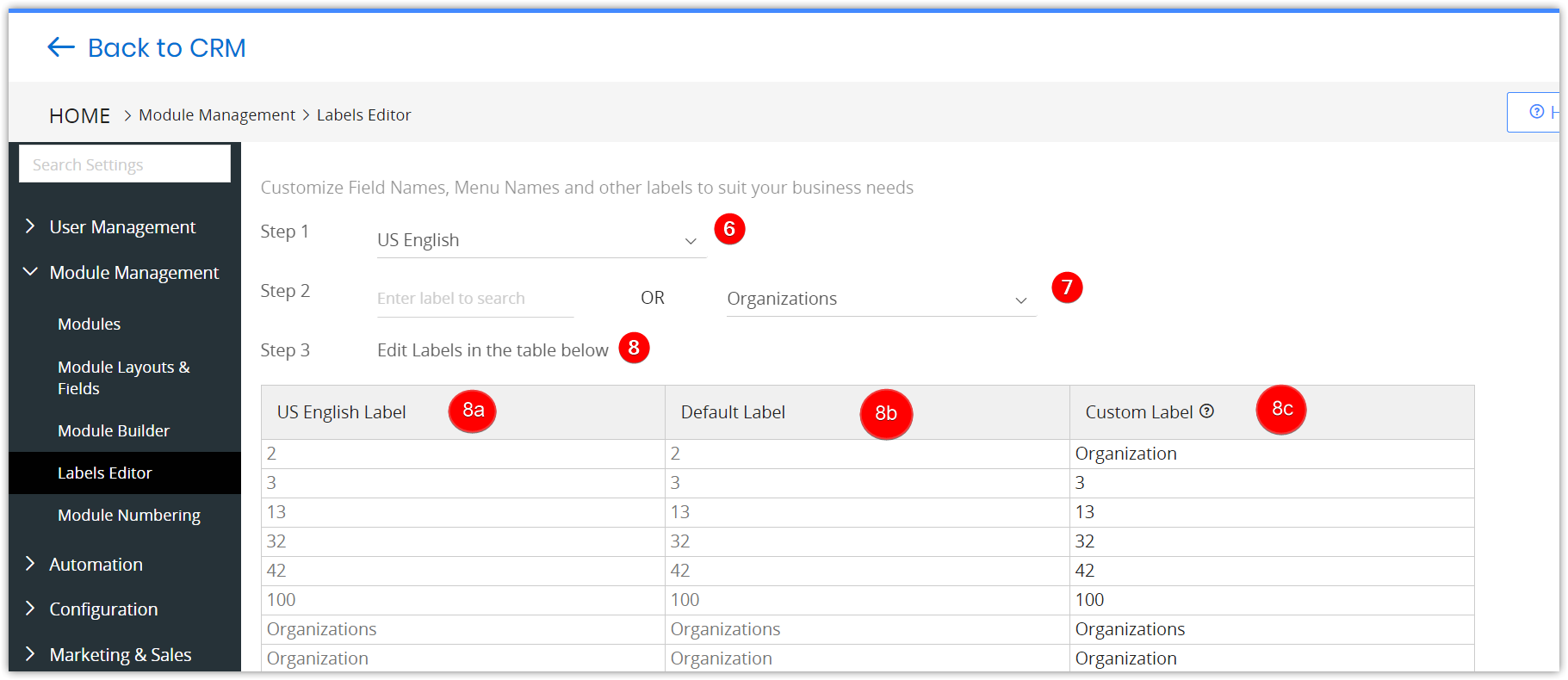Articles in this section
Authenticate Emails with SPF, DKIM, and SenderID
Auto forward your emails to Vtiger
Automate Outgoing Emails in Email Settings
Managing User Profiles
Automation - Approvals
Automation - Assignment Rules
Set up Multi-path Workflows
Creating a Scheduled Workflow
Automation - Scheduler
Creating Workflows in Vtiger CRM
Webforms in Vtiger CRM
Set up a Workflow Action to Create Event
Set up a Workflow Action to Create Records
Set up a Workflow Action to Create Task
Set up a Workflow Action to Invoke Custom Function
Set up a Workflow Action to Create an SMS Task
Set up a Workflow Action to Send Mails
Set up a Workflow Action to Update Fields
Automation - Workflow Action - Webhook
Automation - Workflows - Vtiger Expressions
Configuration - Business Hours
Configuration - Company Details
Configuration - Consents
Configuration - Customer Portal
Maps in Vtiger CRM
Configuration - Usage Details
Configuring Encrypted Data Fields in Vtiger CRM
Configure Picklist Dependencies
Considerations for Deactivating Vtiger Users
Control Fields and Record Displays using Configuration Editor
Create Reminders for Records and Inbox
Create a field of a Grid type
Dealing with Currencies and Taxes
Enable Desktop Notifications on Chrome Web Browsers
Vtiger CRM Add-ons
IMAP Configuration - 2-way sync between Vtiger and IMAP providers
Setting up Autopay & Payment Gateways
Inventory - Tax Management
Inventory - Terms and Conditions
Login to Vtiger on SSO SAML using ADFS
Mailroom Functionality for Different Scenarios
Manage Multiple Currencies
Marketing and Sales - Deal to Project Mapping
Marketing and Sales - Lead Conversion Data Mapping
Marketing and Sales - Profile Scoring
Module Management - Module Numbering
Configure My Preferences Feature
My Preferences - Calendar Settings
Tags in Vtiger
My Preferences - Notification Preferences
SAML Support in Vtiger CRM
Vtiger Mailroom
Settings - Configure Module Settings
Settings - Create Dynamic Fields and Layouts
Module Management - Creating a Relationship Between Modules
Settings - Customize Records and Fields for your Business
Settings - How to set email autoresponder to Webform submission?
Settings - Left Menu
Settings - Manage Global Picklists in Vtiger
Settings - Set up your Support Team
Settings - Start Up Page
Settings - Working with Picklist Values
Module Management - Module Builder
Support - SLA Policies
Troubleshooting Login Issues
Add-Edit Unsubscribe Links in your Email Template
User Management - Authentication
User Management - Encrypted Field Access Logs
User Management - Groups
User Management - Login History
User Management - Profiles
User Management - Roles
User Management - Settings Log
User Management - Sharing Rules
User Management - Users
User Management - Vtiger Support Access
Vtiger Buzz - Chrome Extension for Notifications
Vtiger Implementation wizard
Vtiger Language Support
Configuring Websense Trackers
Websense - Widgets
Creating Standard Workflows in Vtiger
Module Management - Modules
Module Management - Module Layouts & Fields
Generate and Manage Third-party App Passwords in Yahoo
Configuring App Passwords for Gmail Outgoing Server and Yahoo Mail
Configuration - Storage Guard
Customizing your Self-Service Portal Theme Using CSS Styles
Automation - SMS Reply Actions
Adding Hidden Fields to a Webform
Configuring Dependent Fields and Blocks for Modules
Auto forward Emails from Microsoft Office 365
Adding Custom Module
Login Page Customization
Settings - Personalize Module Layouts
Duplicate Prevention in Modules
Formula Fields
Creating Custom Filters
Adding a local DNS Entry
Module Management - Labels Editor
This article will help you rename all the field and label names in Vtiger CRM.
R
Rashmi Kashyap
29 Apr, 2024 - Updated
1 year ago
Introduction
|
|
Using Vtiger CRM’s Labels Editor, you can rename CRM modules and other text areas to make the CRM fit your organization’s structure and terminology.
|
|
Feature Availability
|
|
|
|
| |
|
| ||||
|
|
|
|
|
|
Benefits
The following are the benefits of Labels editor:
- Streamlined User Interface - By customizing labels, the Labels Editor helps streamline the user interface, making it more intuitive and user-friendly.
- Flexibility - The Labels Editor in Vtiger CRM provides the flexibility to adapt labels to new business processes, departments, or products.
- Field Customization - Vtiger CRM allows users to customize the labels of fields used to capture and store information. Users can rename or modify the labels of existing fields or create new custom fields with labels of their choice.
- Module Customization - Vtiger CRM consists of various modules (e.g., Leads, Contacts, Deals) that organize different aspects of customer relationship management.
- Improved User Adoption - Users are more likely to use a CRM system that reflects terminology and language familiar to them.
In this article, you will learn about:
- Editing Label Names
Editing Label Names
Editing field or label names is an effortless task in Vtiger CRM. All you have to do is find the label and rename it!
Follow these steps to edit label names:
- Log in to your CRM account.
- Click the User Menu on the top right corner of the page.
- Click the Settings button.

- Look for the Module Management section.
- Click Labels Editor. You can see the default names for all the labels provided by the CRM.

- Select the language in the Step 1 drop-down.
- Enter the label name to search the CRM or select the module in the Step 2 drop-down.
- Edit the Custom Label column in the table under Step 3. Each column has its significance:
- US English Label - This is the standard column for all the labels.
- Default Label -This column displays all the labels based on the language selected in Step 1.
- Custom Label - This column enables you to customize the label names.
All the edits you make will be auto-saved in the CRM.

|
|